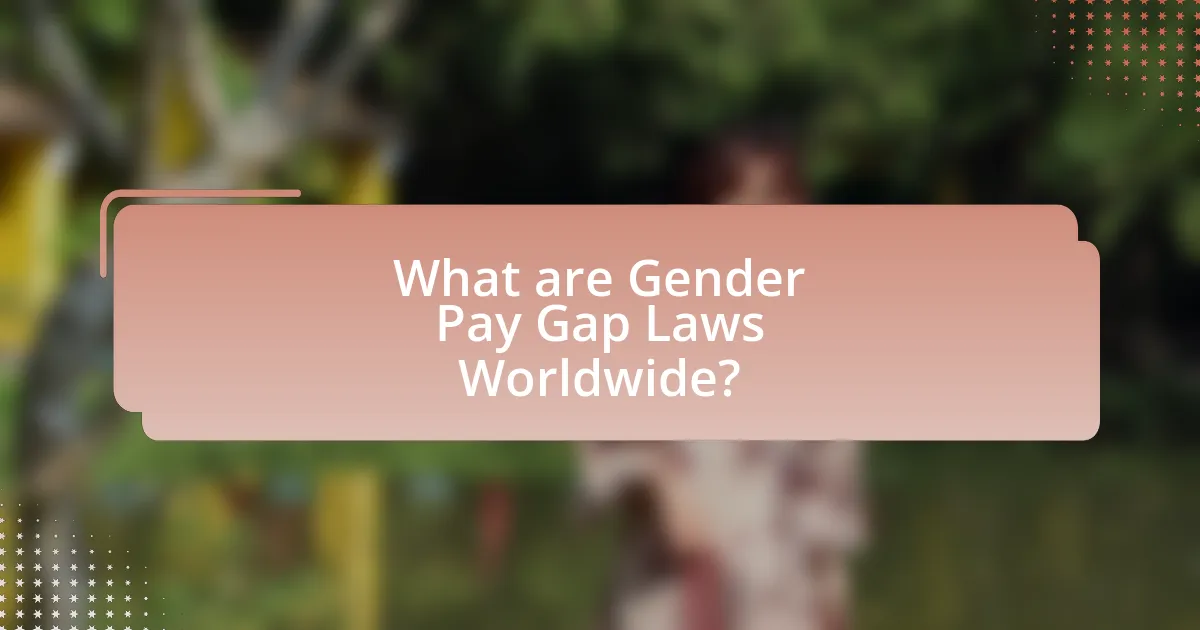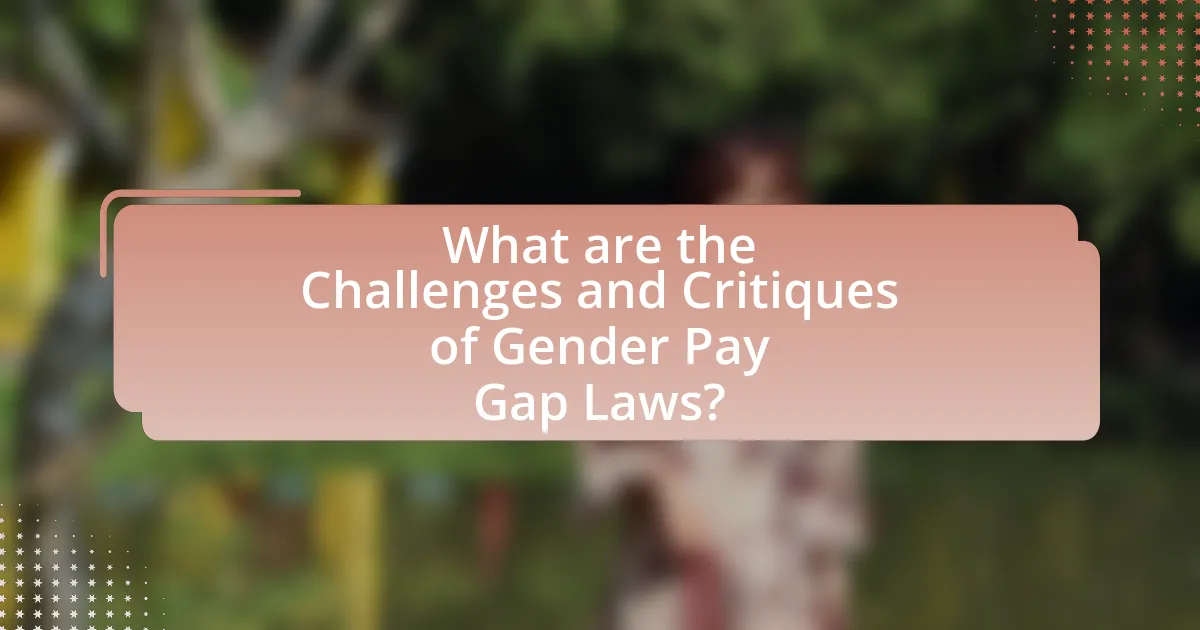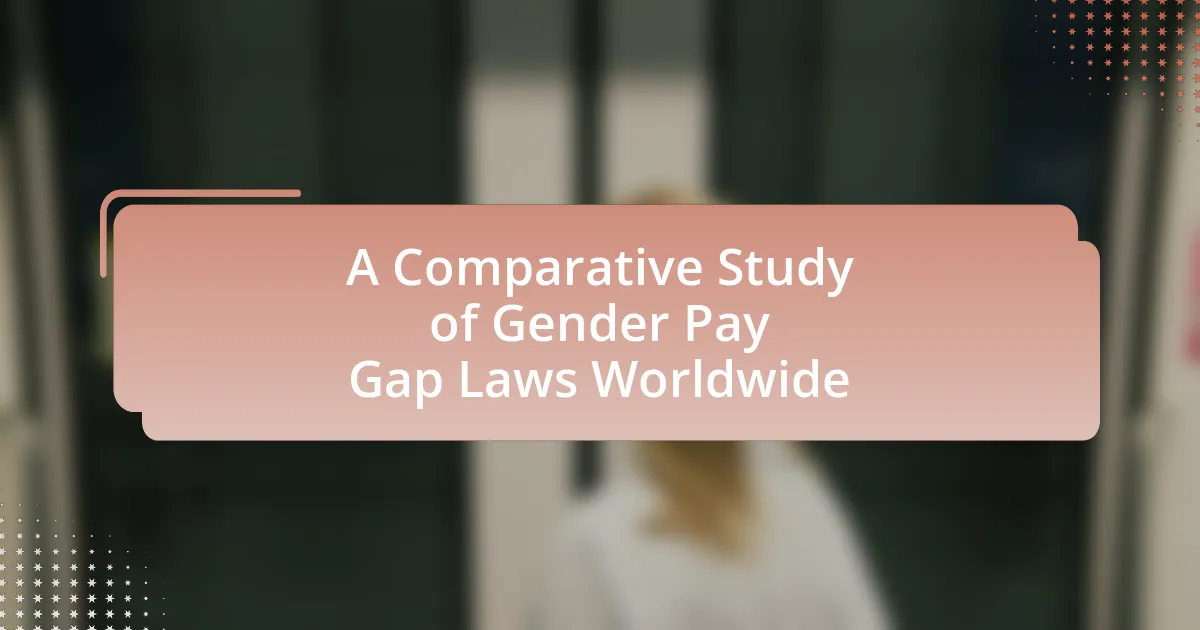The article provides a comprehensive analysis of gender pay gap laws worldwide, highlighting their varying definitions, enforcement mechanisms, and cultural influences. It examines how different countries, such as the United States, the United Kingdom, and Iceland, implement these laws to address wage disparities between men and women. Key metrics for measuring the gender pay gap, the impact of cultural attitudes, and the effectiveness of enforcement are discussed, alongside the challenges and critiques faced by existing legislation. The article also explores successful examples of gender pay gap laws and the practical steps organizations can take to promote pay equity.

What are Gender Pay Gap Laws Worldwide?
Gender pay gap laws worldwide are legal frameworks established to address and reduce the disparity in earnings between men and women. These laws vary significantly by country, with some nations implementing mandatory pay transparency measures, while others enforce equal pay for equal work principles. For instance, the Equal Pay Act of 1963 in the United States mandates that men and women receive equal pay for equal work, while the United Kingdom’s Equality Act 2010 requires employers to provide equal pay for equal work and mandates reporting on gender pay gaps. Additionally, countries like Iceland have taken further steps by implementing legislation that requires companies to prove they are paying men and women equally, with penalties for non-compliance. These laws aim to promote gender equality in the workplace and are supported by various international agreements, such as the Convention on the Elimination of All Forms of Discrimination Against Women (CEDAW).
How do different countries define the gender pay gap?
Different countries define the gender pay gap as the difference in average earnings between men and women, typically expressed as a percentage of men’s earnings. For instance, the European Union defines the gender pay gap as the difference between the average gross hourly earnings of male and female employees, calculated as a percentage of male earnings. In the United States, the gender pay gap is often measured by comparing the median annual earnings of men and women working full-time, with the U.S. Census Bureau reporting that women earned approximately 83% of what men earned in 2020. Similarly, Canada defines the gender pay gap as the difference in average hourly wages between men and women, emphasizing the need for adjustments based on factors like occupation and experience. These definitions highlight the varying methodologies used across countries to quantify the gender pay gap, reflecting different labor market conditions and societal norms.
What metrics are used to measure the gender pay gap in various jurisdictions?
The metrics used to measure the gender pay gap in various jurisdictions include the unadjusted pay gap, adjusted pay gap, and the median earnings ratio. The unadjusted pay gap calculates the difference in average earnings between men and women without accounting for factors such as occupation, education, and experience. The adjusted pay gap, on the other hand, considers these factors to provide a more accurate representation of pay disparities. The median earnings ratio compares the median earnings of women to those of men, offering insight into the distribution of earnings within a population. These metrics are commonly utilized in reports by organizations such as the World Economic Forum and the OECD, which provide statistical analyses of gender pay disparities across different countries.
How do cultural factors influence the definition of the gender pay gap?
Cultural factors significantly influence the definition of the gender pay gap by shaping societal norms, values, and expectations regarding gender roles in the workplace. For instance, in cultures that prioritize traditional gender roles, women may be more likely to occupy lower-paying positions or part-time jobs, which skews the overall pay statistics. Research from the World Economic Forum indicates that countries with more progressive gender norms tend to have smaller gender pay gaps, as seen in Nordic countries where policies support gender equality in the workforce. Additionally, cultural attitudes towards negotiation and assertiveness can affect women’s willingness to advocate for higher salaries, further impacting the pay gap.
Why are gender pay gap laws important?
Gender pay gap laws are important because they aim to ensure equal pay for equal work, thereby promoting fairness and economic justice in the workplace. These laws address systemic discrimination that has historically resulted in women earning less than men for similar roles. For instance, the World Economic Forum’s Global Gender Gap Report 2021 indicates that women globally earn approximately 68% of what men earn, highlighting the persistent wage disparity. By implementing gender pay gap laws, governments can help reduce this gap, enhance women’s economic empowerment, and contribute to overall economic growth.
What impact do these laws have on economic equality?
Gender pay gap laws significantly enhance economic equality by mandating equal pay for equal work, thereby reducing wage disparities between genders. These laws create a legal framework that holds employers accountable for discriminatory pay practices, which can lead to increased earnings for women. For instance, countries like Iceland, which implemented stringent pay equity laws, have seen a notable decrease in the gender pay gap, with the World Economic Forum reporting that Iceland has consistently ranked as the most gender-equal country in the world. This legal enforcement not only promotes fairness in compensation but also encourages a cultural shift towards valuing women’s contributions in the workforce, ultimately fostering a more equitable economic environment.
How do gender pay gap laws affect workplace dynamics?
Gender pay gap laws significantly influence workplace dynamics by promoting equity and transparency in compensation practices. These laws compel organizations to evaluate and disclose pay structures, which can lead to increased awareness of wage disparities among employees. For instance, a study by the Institute for Women’s Policy Research found that states with stronger pay equity laws saw a reduction in the gender pay gap by approximately 7% over a decade. This heightened awareness fosters a culture of accountability, encouraging employers to implement fair pay practices and potentially improving employee morale and retention. Additionally, organizations that comply with these laws often experience enhanced reputational benefits, attracting a more diverse talent pool and fostering an inclusive work environment.
What are the common features of gender pay gap laws?
Common features of gender pay gap laws include requirements for pay transparency, mandates for equal pay for equal work, and provisions for reporting and monitoring pay disparities. Pay transparency laws compel employers to disclose salary ranges and pay scales, which helps identify and address wage gaps. Equal pay mandates ensure that individuals performing similar work receive the same compensation, regardless of gender. Additionally, many laws require organizations to report pay data, enabling authorities to track compliance and assess the effectiveness of these regulations in reducing the gender pay gap. For instance, the Equal Pay Act of 1963 in the United States established the principle of equal pay for equal work, while the Gender Pay Gap Information Act in the UK mandates reporting on pay differences between genders.
What enforcement mechanisms are typically included in these laws?
Enforcement mechanisms typically included in gender pay gap laws are penalties for non-compliance, mandatory reporting requirements, and the establishment of regulatory bodies to oversee compliance. Penalties can involve fines or sanctions imposed on organizations that fail to adhere to pay equity standards, as seen in countries like the United Kingdom, where employers must publish their gender pay gap data annually. Mandatory reporting requirements compel organizations to disclose salary information, which enhances transparency and accountability, as implemented in various jurisdictions including Australia. Regulatory bodies, such as the Equal Employment Opportunity Commission in the United States, are tasked with monitoring compliance and investigating complaints related to pay discrimination, ensuring that laws are enforced effectively.
How do transparency requirements vary across different countries?
Transparency requirements regarding gender pay gap laws vary significantly across countries. For instance, countries like Sweden and Iceland mandate comprehensive reporting on pay disparities, requiring organizations to disclose detailed salary information and conduct regular audits. In contrast, the United States has no federal requirement for pay transparency, although some states, like California, have implemented laws that encourage or require disclosure of pay scales. The European Union has proposed directives to enhance pay transparency, aiming for member states to adopt similar standards. These variations reflect differing cultural attitudes towards gender equality and the role of government in regulating workplace practices.

How do Gender Pay Gap Laws Vary Across Regions?
Gender pay gap laws vary significantly across regions, reflecting differing cultural, economic, and political contexts. For instance, in the European Union, the Pay Transparency Directive mandates that companies disclose pay data to promote gender equality, while in the United States, there is no federal law requiring such transparency, although some states have enacted their own regulations. Additionally, countries like Iceland have implemented strict measures, including mandatory pay audits for companies, resulting in a notable reduction in the gender pay gap. In contrast, regions with less stringent laws, such as parts of Asia and Africa, often see wider pay disparities due to a lack of enforcement mechanisms and cultural norms that may prioritize traditional gender roles. These variations highlight the influence of local legislation and societal attitudes on the effectiveness of gender pay gap laws.
What are the key differences between gender pay gap laws in Europe and North America?
Gender pay gap laws in Europe are generally more comprehensive and enforceable compared to those in North America. In Europe, many countries have implemented mandatory pay transparency measures, such as the EU’s Pay Transparency Directive, which requires employers to disclose pay data to ensure equal pay for equal work. In contrast, North America, particularly the United States, relies more on voluntary reporting and lacks a federal mandate for pay transparency, leading to significant variations in state-level laws. For instance, countries like Iceland have established strict penalties for companies that fail to demonstrate pay equity, while the U.S. has no equivalent federal law enforcing such penalties. This difference in regulatory frameworks highlights Europe’s proactive approach to addressing the gender pay gap compared to the more reactive and fragmented approach seen in North America.
How do enforcement and compliance differ in these regions?
Enforcement and compliance of gender pay gap laws differ significantly across regions, primarily due to variations in legal frameworks and institutional capacities. In regions with robust enforcement mechanisms, such as the European Union, there are stringent regulations and penalties for non-compliance, which compel organizations to adhere to pay equity standards. For instance, the EU’s Directive on Pay Transparency mandates that companies disclose pay data, enhancing accountability. Conversely, in regions like the United States, enforcement is often less rigorous, with reliance on voluntary compliance and limited federal oversight, resulting in a patchwork of state laws that vary in effectiveness. This disparity is evidenced by the World Economic Forum’s Global Gender Gap Report, which highlights that countries with strong enforcement measures show narrower gender pay gaps compared to those with weaker compliance frameworks.
What role do unions play in advocating for gender pay gap laws in these areas?
Unions play a critical role in advocating for gender pay gap laws by mobilizing collective bargaining power to demand equitable pay practices. They actively engage in lobbying efforts, influencing legislation that addresses wage disparities between genders. For instance, unions have historically supported initiatives like the Equal Pay Act and have participated in campaigns to raise awareness about the gender pay gap, which, according to the World Economic Forum, remains at approximately 16% globally. By representing workers’ interests, unions provide a platform for negotiating better pay and benefits, thereby directly impacting gender pay equity.
How do Asian countries approach gender pay gap legislation?
Asian countries approach gender pay gap legislation with varying degrees of commitment and effectiveness, often influenced by cultural, economic, and political factors. For instance, countries like Japan and South Korea have implemented policies aimed at promoting equal pay, such as the Equal Employment Opportunity Law in Japan, which mandates equal treatment in the workplace. However, enforcement remains weak, and traditional gender roles continue to impact women’s participation in the workforce. In contrast, countries like the Philippines have more robust legislation, including the Magna Carta of Women, which promotes gender equality and mandates equal pay for equal work. Despite these efforts, the gender pay gap persists across the region, with the World Economic Forum’s Global Gender Gap Report 2021 indicating that the gender pay gap in East Asia and the Pacific is approximately 20%. This highlights the ongoing challenges and the need for more effective implementation and enforcement of existing laws to achieve true gender pay equity in Asian countries.
What unique challenges do Asian countries face in implementing these laws?
Asian countries face unique challenges in implementing gender pay gap laws due to cultural norms, economic disparities, and varying levels of legal enforcement. Cultural attitudes towards gender roles often hinder the acceptance and enforcement of such laws, as traditional views may prioritize male employment and authority. Economic disparities, including a significant informal labor market, complicate the measurement and enforcement of pay equity, as many workers are not covered by formal regulations. Additionally, the varying levels of legal infrastructure and enforcement capabilities across different Asian nations lead to inconsistent application of these laws, making it difficult to achieve uniform progress in closing the gender pay gap. For instance, countries like India and Bangladesh struggle with high levels of informal employment, which limits the effectiveness of formal pay equity laws.
How do cultural attitudes towards gender roles impact legislation in Asia?
Cultural attitudes towards gender roles significantly influence legislation in Asia by shaping policymakers’ perceptions and priorities regarding gender equality. In many Asian countries, traditional views often prioritize male authority and female subservience, which can lead to the enactment of laws that reinforce these roles rather than promote equality. For instance, countries like India and Japan have faced challenges in implementing effective gender pay gap laws due to societal norms that undervalue women’s work and perpetuate stereotypes about gender roles. Research by the World Economic Forum in 2021 highlights that countries with more progressive cultural attitudes towards gender roles, such as the Philippines, tend to have more robust legislation aimed at closing the gender pay gap, demonstrating a direct correlation between cultural perceptions and legislative outcomes.
What lessons can be learned from countries with successful gender pay gap laws?
Countries with successful gender pay gap laws demonstrate that transparency in pay practices significantly reduces wage disparities. For instance, in Iceland, mandatory pay audits for companies have led to a notable decrease in the gender pay gap, which was reported to be 14% in 2020, down from 20% in previous years. Additionally, effective enforcement mechanisms, such as penalties for non-compliance, encourage organizations to adhere to equitable pay practices. Furthermore, public awareness campaigns in countries like Sweden have fostered a cultural shift towards valuing gender equality in the workplace, resulting in a more equitable labor market. These examples illustrate that comprehensive legislation, coupled with transparency and cultural support, is essential for closing the gender pay gap.
Which countries have seen significant reductions in the gender pay gap due to legislation?
Iceland and Norway have seen significant reductions in the gender pay gap due to legislation. Iceland implemented the Equal Pay Act in 1961 and further strengthened it in 2018 by requiring companies to prove they pay men and women equally. As a result, Iceland has consistently ranked as the most gender-equal country in the world, with a gender pay gap of only 14.5% as of 2021. Norway’s Gender Equality Act, enacted in 1978, mandates equal pay for equal work and has contributed to a reduction in the gender pay gap to approximately 16% in 2020. These legislative measures have been pivotal in promoting gender equality in the workforce.
What best practices can be adopted from these successful examples?
Best practices that can be adopted from successful examples of gender pay gap laws worldwide include implementing transparent pay structures, conducting regular pay audits, and enforcing penalties for non-compliance. Transparent pay structures, as seen in countries like Iceland, help ensure that employees are aware of pay scales, reducing discrimination. Regular pay audits, practiced in the UK, allow organizations to identify and address pay disparities proactively. Enforcing penalties for non-compliance, as implemented in Germany, serves as a deterrent against wage discrimination, promoting accountability among employers. These practices have proven effective in narrowing the gender pay gap and fostering equitable workplaces.

What are the Challenges and Critiques of Gender Pay Gap Laws?
Gender pay gap laws face several challenges and critiques, primarily related to enforcement, effectiveness, and unintended consequences. Enforcement is often weak, as many countries lack the resources or political will to monitor compliance effectively, leading to minimal impact on actual pay disparities. Effectiveness is questioned because these laws may not address the root causes of the pay gap, such as occupational segregation and discrimination, which persist despite legal frameworks. Additionally, critics argue that such laws can lead to unintended consequences, such as employers adjusting salaries in ways that do not genuinely promote equity, or even reducing hiring opportunities for women due to perceived risks associated with compliance. Studies, such as those conducted by the Institute for Women’s Policy Research, indicate that while legislation can raise awareness, it often falls short in achieving substantial wage equality without accompanying measures that tackle broader societal issues.
What are the common criticisms of existing gender pay gap laws?
Common criticisms of existing gender pay gap laws include their ineffectiveness in addressing the root causes of wage disparities, lack of enforcement mechanisms, and insufficient data transparency. Critics argue that these laws often focus on reporting pay differences rather than implementing measures to rectify systemic issues such as occupational segregation and discrimination. For instance, a report by the World Economic Forum highlights that while many countries have introduced pay gap reporting, the actual wage gap remains largely unchanged, indicating that mere transparency does not lead to actionable change. Additionally, enforcement is often weak, with penalties for non-compliance being minimal, which fails to incentivize organizations to take meaningful steps toward equity.
How do critics argue that these laws may not effectively address the pay gap?
Critics argue that these laws may not effectively address the pay gap because they often fail to tackle the root causes of wage disparities, such as occupational segregation and discrimination. For instance, a study by the Institute for Women’s Policy Research found that even in countries with strong pay equity laws, women continue to be concentrated in lower-paying industries, which perpetuates the pay gap. Additionally, critics highlight that enforcement mechanisms are often weak, leading to minimal compliance from employers. The lack of transparency in pay practices further complicates the issue, as many organizations do not disclose salary information, making it difficult to hold them accountable for inequities.
What unintended consequences have been observed in countries with strict gender pay gap laws?
Countries with strict gender pay gap laws have observed unintended consequences such as reduced hiring of women, increased wage disparities in certain sectors, and a potential decrease in overall workforce participation. For instance, in countries like Sweden and Germany, stringent regulations led some employers to limit hiring women for higher-paying positions due to concerns over compliance costs and potential penalties. Additionally, studies indicate that while the laws aim to promote equality, they can inadvertently create a backlash where employers may favor male candidates to avoid the complexities of wage adjustments, thus exacerbating gender disparities in specific industries. Research from the Institute for the Study of Labor (IZA) highlights that these laws can lead to a “glass ceiling” effect, where women are less likely to be promoted into leadership roles, counteracting the intended benefits of the legislation.
How do enforcement challenges affect the effectiveness of gender pay gap laws?
Enforcement challenges significantly undermine the effectiveness of gender pay gap laws by creating barriers to compliance and accountability. When organizations lack clear guidelines or face insufficient resources for monitoring, they may not adhere to the regulations, leading to persistent wage disparities. For instance, a study by the Institute for Women’s Policy Research found that only 30% of companies in jurisdictions with gender pay gap reporting requirements fully comply, indicating a gap between legislation and actual practice. Additionally, the lack of robust penalties for non-compliance further diminishes the incentive for organizations to rectify pay inequalities, thereby perpetuating the gender pay gap.
What resources are necessary for effective enforcement of these laws?
Effective enforcement of gender pay gap laws requires adequate funding, trained personnel, and robust data collection systems. Funding is essential to support the implementation of enforcement mechanisms, including audits and investigations. Trained personnel, such as labor inspectors and compliance officers, are necessary to interpret and apply the laws effectively. Additionally, robust data collection systems are crucial for monitoring compliance and assessing the impact of these laws, as evidenced by studies showing that jurisdictions with comprehensive data reporting mechanisms have seen more significant reductions in the gender pay gap.
How do disparities in legal frameworks impact enforcement outcomes?
Disparities in legal frameworks significantly impact enforcement outcomes by creating inconsistencies in how gender pay gap laws are applied and upheld across different jurisdictions. For instance, countries with robust legal protections and clear enforcement mechanisms, such as the United Kingdom, tend to see more effective compliance and reporting from employers, resulting in a narrower gender pay gap. In contrast, nations with vague laws or weak enforcement, like the United States, often experience limited accountability, leading to persistent wage disparities. Research from the International Labour Organization indicates that countries with comprehensive legal frameworks and active monitoring systems achieve better enforcement outcomes, thereby reducing the gender pay gap more effectively than those lacking such structures.
What practical steps can organizations take to comply with gender pay gap laws?
Organizations can comply with gender pay gap laws by conducting regular pay audits to identify and address disparities. These audits should analyze compensation data across gender and job roles, ensuring transparency in pay structures. Additionally, organizations should implement clear policies for pay equity, provide training on unconscious bias, and establish a framework for reporting and addressing pay discrepancies. Research indicates that companies with transparent pay practices see a reduction in gender pay gaps, as evidenced by a 2020 study from the Institute for Women’s Policy Research, which found that organizations that actively monitor and adjust pay practices can significantly improve gender equity in compensation.
How can companies conduct effective pay audits to identify gaps?
Companies can conduct effective pay audits to identify gaps by systematically analyzing compensation data across various demographics, including gender, race, and job roles. This process involves collecting comprehensive salary information, categorizing employees based on relevant factors, and comparing compensation levels to identify discrepancies. For instance, a study by the Institute for Women’s Policy Research found that organizations that regularly perform pay audits can reduce gender pay gaps by up to 38%. By utilizing statistical analysis tools and benchmarking against industry standards, companies can pinpoint areas of inequity and implement corrective measures, ensuring compliance with gender pay gap laws and promoting fair compensation practices.
What strategies can organizations implement to promote pay equity?
Organizations can implement several strategies to promote pay equity, including conducting regular pay audits, establishing transparent pay scales, and providing training on unconscious bias. Regular pay audits help identify discrepancies in compensation across different demographics, allowing organizations to address inequities. Transparent pay scales ensure that employees understand how salaries are determined, fostering trust and accountability. Training on unconscious bias equips managers and HR personnel with the tools to recognize and mitigate biases that may influence pay decisions. According to a 2020 report by the World Economic Forum, organizations that adopt these strategies can significantly reduce the gender pay gap and promote a more equitable workplace.


